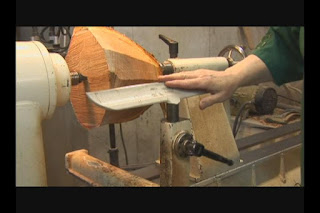Use sharp tools
This makes turning much easier and quicker, and means that the wood is cut smoothly. My bowl gouge needs sharpening about four times for one bowl, so you may wish to buy an electric grinder to make sharpening quick and easy.
Practice with each tool
It took me a while before I could cut smoothly and without dig-ins. So get yourself a piece of scrap wood and practice different techniques on it until you get good at them. For between centres work, you need to be able to: rough out (gouge), smooth (skew chisel), and form shapes (parting/beading tool, spindle gouge). When I make bowls, I use only one tool (a bowl gouge) for almost everything, so don't feel that you must have loads of tools to begin with! Also, try not to be put off if a tool snatches (usually the skew chisel) as this will be remedied with practice.
Get a book or video
There are lots of woodturning books and videos which I found very useful. If there is another woodturner in your area, get in touch, but if not, books and videos give lots of advice and tips. They also show people actually woodturning so you can see what to do. There are lots of woodturning sites on the internet too
Use different grades of sandpaper
Start with the roughest, sanding until all tool marks are gone. Change to a finer grade to get rid of the rough sandpaper scratches. Finally, use an even finer grade to get the wood glassy smooth. I use '150', '240', and '320' sandpaper. You can get the wood even better still if you hold a handful of wood shavings against it to 'burnish' the surface.
Check before switching on
Before you start the lathe, spin the wood to check that it won't hit anything on the way round. Check that all bolts/clamps are tight too. Remember your safety glasses just in case the unexpected happens! If you are sanding the wood wear a dust mask, especially with exotic hardwoods.

No comments:
Post a Comment